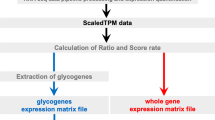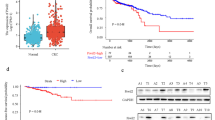Abstract
Hyaluronan plays important roles in the complex processes of tumor invasion and metastasis. It is now known that three hyaluronan synthase (HAS) isoforms catalyze hyaluronan synthesis, which raises the question of how they are involved in malignant tumor progression. In this study, we examined the correlation between tumor progression and transcriptional levels of three HAS isoforms in specimens of human colon cancers. Tumor tissues from 31 patients with different diagnostic grades were assessed to determine the level of each HAS isoform by real time RT-PCR. The mean expression coefficients for HAS1, HAS2 and HAS3 in the cancerous parts were 0.82-, 0.91- and 1.22-fold, respectively; of those in the noncancerous parts at Dukes' stage A; 1.00-, 0.95- and 1.06-fold, respectively, at stage B; and 1.95-, 1.16- and 1.19-fold, respectively, at stage C. In survival analysis, a significant correlation was observed between poor survival and the HAS1 transcript level. When the ratio of tumor to normal tissue in the HAS1 level was compared with that of the HA receptor transcript level, there was a positive correlation with that of the CD44 variant 6 level at Dukes' stage C. Our current results therefore suggest that HAS1 plays a role in the malignant progression of human colon cancer cells.
Similar content being viewed by others
References
Laurent TC, Fraser JR. Hyaluronan. FASEB J 1992; 6: 2397–404.
Toole BP. Proteoglycans and hyaluronan in morphogenesis and differentiation. In Hey ED (<nt>ed</nt>): Cell Biology of the Extracellular Matrix. New York: Plenum Publishing 1980; 259–94.
Turley EA. The role of a cell-associated hyaluronan-binding protein in fibroblast behaviour. In Whelan J (<nt>ed</nt>): The Biology of Hyaluronan, Ciba Foudation Symposium 143. New York: Wiley 1989; 121–37.
Toole BP. Hyaluronan and its binding proteins, the hyaladherins. Curr Opin Cell Biol 1990; 2: 839–44.
Ropponen K, Tammi M, Parkkinen J et al. Tumor cell-associated hyaluronan as an unfavorable prognostic factor in colorectal cancer. Cancer Res 1998; 58: 342–7.
Llaneza A, Vizoso F, Rodriguez JC et al. Hyaluronic acid as prognostic marker in resectable colorectal cancer. Br J Surg 2000; 87: 1690–6.
Lokeshwar VB, Rubinowiez D, Schroeder GL et al. Stromal and epithelial expression of tumor markers hyaluronic acid and HYAL1 hyaluronidase in prostate cancer J Biol Chem 2001; 276: 11922–32.
Hiltunen ELJ, Anttila M, Kultti A et al. Elevated hyaluronan concentration without hyaluronidase activation in malignant epithelial ovarian tumors. Cancer Res 2002; 62: 6410–3.
Wielenga VJM, Heider K, Offerhaus JA et al. Expression of CD44 variant proteins in human colorectal cancer is related to tumor progression. Cancer Res 1993; 53: 4754–6.
Koopman G, Hieder KH, Horst E et al. Activated human lymphocytes and aggressive non-Hodgkin's lymphomas express a homologue of the metastasis associated variant of CD44. J Exp Med 1993; 177; 879–904.
Kaufmann M, Heider KH, Sinn HP et al. CD44 variant exon epitopes in primary breast cancer and length of survival. Lancet 1995; 345: 615–9.
Abetamann V, Kern HF, Elsasser HP. Differential expression of the hyaluronan receptors CD44 and RHAMMin human pancreatic cancer cells. Clin Cancer Res 1996; 2: 1607–18.
Turley EA. Hyaluronan and cell locomotion. Cancer Metast Rev 1992; 11: 21–30.
Knudson W. Tumor-associated hyaluronan providing an extracellular matrix that facilitates invasion. Am J Pathol 1996; 148: 1721–6.
Weigel PH, Hascall VC, Tammi M. Hyaluronan synthases. J Biol Chem 1997; 272: 13997–14000.
Itano N, Kimata K. Hyaluronan synthase: New directions for hyaluronan research. Trends Glycosci Glycotechnol 1998; 10: 23–38.
Spicer AP, Nguyen TK. Mammalian hyaluronan synthases: investigation of functional relationships in vivo. Biochem Soc Trans 1999; 27: 109–15.
Spicer AP, McDonald JA. Characterization and molecular evolution of a vertebrate hyaluronan synthase gene family. J Biol Chem 1998; 273: 1923–32.
Itano N, Sawai T, Yoshida M et al. Three isoforms of mammalian hyaluronan synthases have distinct enzymatic properties. J Biol Chem 1999; 274: 25085–92.
Kosaki R, Watanabe K, Yamaguchi Y. Overproduction of hyaluronan by expression of the hyaluronan synthase Has2 enhances anchorageindependent growth and tumorigenicity. Cancer Res 1999; 59: 1141–5.
Itano N, Sawai T, Miyaishi O et al. Relationship between hyaluronan production and metastatic potential of mouse mammary carcinoma cells. Cancer Res 1999; 59: 2499–504.
Ichikawa T, Itano N, Sawai T et al. Increased synthesis of hyaluronate enhances motility of human melanoma cells. J Invest Dermatol 1999; 113: 953–9.
Liu N, Gao F, Han Z et al. Hyaluronan synthase 3 overexpression promotes the growth of TSU prostate cancer cells. Cancer Res 2001; 61: 5207–14.
Li Y, Heldin P. Hyaluronan production increases the malignant properties of mesothelioma cells. Br J Cancer 2001; 85: 600–7.
Simpson MA, Wilson CM, Furcht L et al. Manipulation of hyaluronan synthase expression in prostate adenocarcinoma cells alters pericellular matrix retention and adhesion to bone marrow endothelial cells. J Biol Chem 2002; 277: 10050–7.
Enegd B, King JA, Stylli S et al. Overexpression of hyaluronan synthase-2 reduces the tumorigenic potential of glioma cells lacking hyaluronidase activity. Neurosurgery 2002; 50: 1311–8.
Jacobson A, Rahmanian M, Rubin K et al. Expression of hyaluronan synthase 2 or hyaluronidase 1 differentially affect the growth rate of transplantable colon carcinoma cell tumors. Int J Cancer 2002; 102: 212–9.
Itano N, Atsumi F, Sawai T et al. Abnormal accumulation of hyaluronan matrix diminishes contact inhibition of cell growth and promotes cell migration. Proc Natl Acad Sci USA 2002; 99: 3609–14.
Turnbull RB, Kyle K, Watson FB et al. Cancer of the colon: The influence of the no-touch isolation technique on survival rates. Ann Surg 1967; 166: 400–27.
Itano N, Kimata K. Molecular cloning of human hyaluronan synthase. Biochem Biophys Res Commun 1996; 222: 816–20.
Sugiyama Y, Shimada A, Sayo T et al. Putative hyaluronan synthase mRNA are expressed in mouse skin and TGF-beta upregulates their expression in cultured human skin cells. J Invest Dermatol 1998; 110: 116–21.
Jacobson A, Brinck J, Briskin MJ et al. Expression of human hyaluronan synthases in response to external stimuli. Biochem J 2000; 348 Pt 1: 29–35.
Pienimaki JP, Rilla K, Fulop C et al. Epidermal growth factor activates hyaluronan synthase 2 in epidermal keratinocytes and increases pericellular and intracellular hyaluronan. J Biol Chem 2001; 276: 20428–35.
Kinzler KW, Vogelstein B. Lessons from hereditary colorectal cancer. Cell 1996; 87: 159–70.
Fearon ER, Vogelstein B. Agenetic model for colorectal tumorigenesis. Cell 1990; 61: 759–67.
Vogelstein B, Kinzler KW. p53 function and dysfunction. Cell 1992; 70: 523–6.
Yamada Y, Itano N, Zako M et al. The gene structure and promoter sequence of mouse hyaluronan synthase 1. Biochem J 1998; 330 Pt 3: 1223–7.
Levine AJ, Momand J, Finlay CA. The p53 tumour suppresser gene. Nature 1991; 351: 453–6.
Harada H, Kitagawa M, Tanaka N et al. Anti-oncogenic and oncogenic potentials of interferon regulatory factors-1 and-2. Science 1993; 259: 971–4.
Yim JH, Wu SJ, Casey MJ et al. IFN regulatory factor-1 gene transfer into an aggressive, nonimmunogenic sarcoma suppresses the malignant phenotype and enhances immunogenicity in syngenic mice. J Immunol 1997; 158: 1284–92.
Turley EA, Noble PW, Bourguignon LY. Signaling properties of hyaluronan receptors. J Biol Chem 2002; 277: 4589–92.
Hall CL, Yang B, Yang X et al. Overexpression of the hyaluronan receptor RHAMM is transforming and is also required for H-ras tranformation. Cell 1995; 82: 19–28.
Wang C, Thor AD, Moore II DH et al. The Overexpression of RHAMM, a hyaluronan-binding protein that regulates ras signaling, correlates with overexpression of mitogen-activated protein kinase and is a significant parameter in breast cancer progression. Clin Cancer Res 1998; 4: 567–76.
Reeder JA, Gotley DC, Walsh MD et al. Expression of antisense CD44 variant 6 inhibits colorectal tumor metastasis and tumor growth in a wound environment. Cancer Res 1998; 58: 3719–26.
Yamada Y, Itano N, Narimatsu H et al. RHAMM, Receptor for hyaluronan-mediated motility and CD44 expressions in colon cancer assessed by quantitative analysis using real time RT-PCR. Jpn J Cancer Res 1999; 90: 987–92.
Yamada Y, Itano N, Narimatsu H et al. CD44 variant exon 6 expressions in colon cancer assessed by quantitative analysis using real time reverse transcriptase-polymerase chain reaction. Oncol Rep 2003; 10: 1919–24.
Author information
Authors and Affiliations
Corresponding author
Rights and permissions
About this article
Cite this article
Yamada, Y., Itano, N., Narimatsu, H. et al. Elevated transcript level of hyaluronan synthase1 gene correlates with poor prognosis of human colon cancer. Clin Exp Metastasis 21, 57–63 (2004). https://doi.org/10.1023/B:CLIN.0000017203.71293.e0
Issue Date:
DOI: https://doi.org/10.1023/B:CLIN.0000017203.71293.e0




